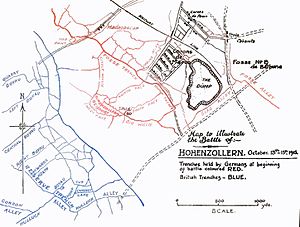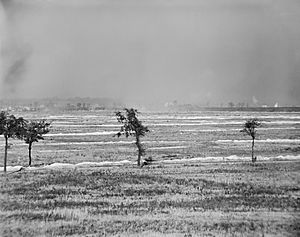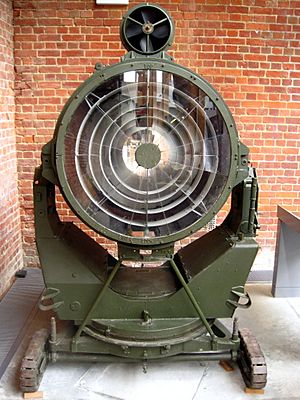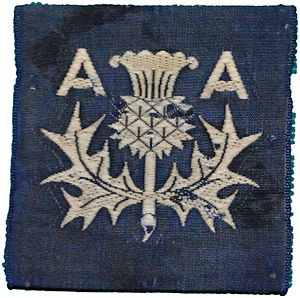5th Battalion, Lincolnshire Regiment facts for kids
Quick facts for kids 5th Battalion, Lincolnshire Regiment46th Searchlight Regiment, RA 606 Infantry Regiment, RA 581 Heavy AA Regiment, RA |
|
|---|---|
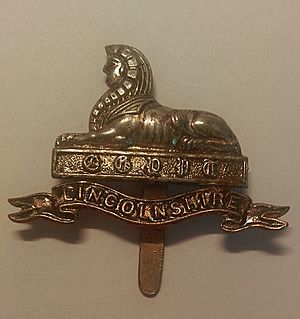
Lincolnshire Regiment Cap Badge
|
|
| Active | 1 April 1908–10 March 1955 |
| Country | |
| Branch | |
| Role | Infantry (1908–36, 1944–45) Air Defence (1936–44, 1947–67) |
| Garrison/HQ | Grimsby |
| Engagements | WWI: Hohenzollern Redoubt Gommecourt Hill 70 3rd Ypres Bourlon Wood German spring offensive St Quentin Canal German spring offensive Bailleul WWII: Newcastle Blitz North West Europe |
The 5th Battalion, Lincolnshire Regiment (often called the 5th Lincolns) was a special army unit in Britain. It was part of the Territorial Army from 1900 to 1967. This unit started as soldiers who volunteered their time. They fought as regular foot soldiers (infantry) in the First World War. After that, they became an air defence unit, protecting against enemy planes during and after the Second World War.
Contents
How the Unit Started: Volunteers!
Before 1908, this unit was known as the 3rd Volunteer Battalion, Lincolnshire Regiment. It was formed in June 1900. This battalion was made up of six smaller groups of volunteers. These groups were based in the northern and eastern parts of Lincolnshire. Their main office was in Grimsby.
Many of the volunteers came from different jobs. In Grimsby, many were from the fishing industry. In other areas like Scunthorpe, they worked in iron factories. Farmers from places like Louth and Spilsby also joined.
Joining the Territorial Force
In 1908, the volunteer army changed. It became the Territorial Force (TF). The 3rd Volunteer Battalion became the 5th Battalion Lincolnshire Regiment. More companies joined them, including some from Gainsborough. The first leader of the 5th Battalion was Lieutenant-Colonel George Beaumont Walker.
The 5th Lincolns, along with other battalions, became part of the 46th (North Midland) Division. This division was important for training and preparing soldiers.
Serving in the First World War
Getting Ready for War
In July 1914, the 5th Lincolns were at their yearly training camp. But the world situation became very tense. On August 4, 1914, they received orders to get ready for war. Within two days, the whole battalion gathered in Grimsby.
Their first jobs were to guard the docks and power stations in Grimsby. They also dug trenches near the Humber river. Soon, they moved to Luton for more training.
Many men volunteered to serve overseas. The battalion grew to 650 soldiers and was ready for foreign service. Those who did not volunteer stayed to form a reserve unit. Eventually, there were three versions of the battalion:
- 1/5th Battalion: This was the main unit that went overseas.
- 2/5th Battalion: This unit was formed from new recruits and those who stayed home.
- 3/5th Battalion: This was a reserve unit that trained new soldiers.
1/5th Battalion: Fighting on the Western Front
The 1/5th Lincolns arrived in France in March 1915. They were part of the 46th (North Midland) Division. This was the first full Territorial Force division to reach the Western Front. They learned about trench warfare near Ploegsteert in the Ypres Salient.
The Hohenzollern Redoubt Battle
In October 1915, the 1/5th Lincolns were part of a big attack on a German stronghold called the Hohenzollern Redoubt. This was a very tough battle.
On October 13, the soldiers attacked after a gas cloud was released. They faced heavy machine gun fire. Many soldiers were lost, and almost all the officers were wounded or killed. Sergeant Harry Drewery was a hero, keeping his machine gun firing even when almost everyone else was gone. He won a medal for his bravery.
After this battle, the division was supposed to go to Egypt. But the orders changed, and they returned to France in February 1916. They continued to hold trenches and fight.
Gommecourt Attack
In July 1916, the division moved south to join the Battle of the Somme. They were ordered to attack the Gommecourt Salient on July 1. This attack was a distraction from the main battle.
The 1/5th Lincolns were in reserve. They moved up under heavy artillery fire. Later, they were ordered to attack German trenches at midnight. But the German wire was not cut, and the attack failed. They brought back wounded soldiers from No man's land. This action cost them more casualties.
Fighting at Lens and Hill 70
In April 1917, the division moved to the Lens area. They fought for ten weeks around Hill 70. The 1/5th Lincolns were involved in street fighting and suffered losses from shelling. They also carried out attacks on June 19 and June 30.
Breaking the Hindenburg Line
The 46th Division was given a very difficult task in September 1918. They had to cross the St. Quentin Canal, which was part of the strong German Hindenburg Line.
On September 29, the 5th Lincolns followed other brigades across the canal. They had support from tanks. They quickly reached their goals, taking many prisoners with few losses.
Ramicourt and Andigny Battles
The division fought again at Ramicourt on October 3. The 5th Lincolns helped push back a German counter-attack.
The Battle of Andigny on October 17 was their last big fight of the war. The 5th Lincolns advanced through mist and faced strong German resistance. They eventually took their objectives.
As the war ended, the battalion pursued the retreating Germans. On November 6, they had to cross the Petit Helpe river, where bridges were destroyed. They used carts, planks, and even felled trees to cross. The Armistice came into effect on November 11, 1918.
After the war, the battalion helped with clean-up work. Soldiers began returning home in February 1919. The unit was officially disbanded in July 1919.
2/5th Battalion: The Second Line
The 2/5th Battalion was formed in February 1915 in Grimsby. It was made up of new recruits and those who stayed in Britain. They trained with old Japanese rifles because there weren't enough modern ones.
Service in Ireland
In April 1916, the 2/5th Battalion was sent to Dublin to help stop the Easter Rising. They were among the first Territorial Force units to serve in Ireland. They stayed there until the end of the year.
Hindenburg Line and Polygon Wood
In March 1917, the 2/5th Lincolns moved to France. They followed the Germans as they retreated to the Hindenburg Line. They suffered heavy losses in an attack near Hargicourt in April.
In September, they moved to the Ypres Salient for the 3rd Ypres Offensive. They fought in the Battle of Polygon Wood on September 26. The battalion advanced well, taking German positions and pillboxes. Even though they won, they had many casualties.
Bourlon Wood and German Spring Offensive
The 2/5th Battalion then moved to the Battle of Cambrai. They held positions in Bourlon Wood.
In March 1918, the German spring offensive began. The 2/5th Lincolns faced a huge German attack. Three of their companies were cut off and captured. The remaining soldiers fought hard but suffered heavy losses.
They continued to fight in April at the Battle of Bailleul, where they again had many casualties. Because of these heavy losses, the 2/5th Battalion was eventually disbanded in July 1918. Its remaining soldiers joined the 1/5th Battalion.
Between the World Wars
The 5th Lincolns was reformed in 1920 as part of the Territorial Army (TA). They were again part of the 46th (North Midland) Division.
The unit had companies in different towns like Grimsby, Louth, Gainsborough, and Scunthorpe. Recruiting was good in some areas, like Gainsborough. In 1933, they even opened a new office in Brigg because so many people wanted to join.
Becoming an Anti-Aircraft Unit
In December 1936, the 5th Lincolns changed its role. It became an anti-aircraft (AA) unit, using searchlights to find enemy planes. It was renamed the 46th (The Lincolnshire Regiment) Anti-Aircraft Battalion, RE (TA). They had companies in Grimsby, Barton, and Brigg.
Serving in the Second World War
Getting Ready for War Again
The TA's AA units were called up in September 1938 during a crisis. They quickly set up their equipment. In August 1939, just before war was declared, the AA Command was fully ready.
The 46th AA Battalion helped protect the Humber area. They also controlled other searchlight companies. In March 1940, they moved to the Newcastle upon Tyne area to protect cities there.
Battle of Britain and The Blitz
In August 1940, the AA battalions became part of the Royal Artillery (RA). The unit was renamed 46th (Lincolnshire Regiment) Searchlight Regiment, RA. They kept their old cap badge.
They served during the Battle of Britain and The Blitz, which were periods of heavy German bombing. They helped defend cities like Newcastle.
In December 1941, the regiment moved to Scotland to protect Edinburgh and the Forth. Later, they moved even further north to the Orkney and Shetland Islands.
By 1944, fewer searchlight units were needed in Britain. Many soldiers were needed for fighting overseas, especially for the planned invasion of Normandy (Operation Overlord). So, one of their batteries was disbanded.
Fighting in North West Europe
By late 1944, the German air force was much weaker. The British Army started changing some artillery units into infantry battalions. This was to help with the shortage of foot soldiers.
On November 4, 1944, the 46th Searchlight Regiment was changed into the 46th (Lincolnshire Regiment) Garrison Regiment, RA.
In January 1945, this unit was changed again. It became 606 Infantry Regiment, RA. They went to North West Europe the next month. They served with the Second Army until VE Day (Victory in Europe Day).
After the Wars
When the Territorial Army was reformed in 1947, the regiment was brought back. It was called 581 (5th Battalion Royal Lincolnshire Regiment) (Mixed) Heavy Anti-Aircraft Regiment, RA. The word 'mixed' meant that women from the Women's Royal Army Corps were part of the unit.
In 1955, many AA units were merged. The 581st HAA joined other units to form a new regiment. After 1967, the Territorial Army changed again, and the Lincolnshire Regiment link was eventually stopped.
Memorials
There are memorials that remember the actions of the 46th (North) Midland Division. These include their battles at the Hohenzollern Redoubt in 1915 and the St Quentin Canal in 1918. A cross and candlesticks with the badge of the 59th (2nd North Midland) Division were given to Lincoln Cathedral.
Images for kids
-
Memorial near Bellenglise (St Quentin Canal)


